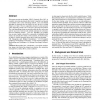83
Voted
VISUALIZATION
1997
IEEE
15 years 4 months ago
1997
IEEE
Genus-reducing simplifications are important in constructing multiresolution hierarchies for level-of-detail-based rendering, especially for datasets that have several relatively ...
110
click to vote
VISUALIZATION
1997
IEEE
15 years 4 months ago
1997
IEEE
We present a multiresolution framework, called Multi-Tetra framework, that approximates volume data with different levelsof-detail tetrahedra. The framework is generated through a...
VISUALIZATION
1997
IEEE
15 years 4 months ago
1997
IEEE
Different techniques have been proposed for rendering volumetric scalar data sets. Usually these approaches are focusing on orthogonal cartesian grids, but in the last years resea...
103
Voted
VISUALIZATION
1997
IEEE
15 years 4 months ago
1997
IEEE
In recent years scientific visualization has been driven by the need to visualize high-dimensional data sets within high-dimensional spaces. However most visualization methods ar...
115
click to vote
VISUALIZATION
1997
IEEE
15 years 4 months ago
1997
IEEE
Oriented Line Integral Convolution (OLIC) illustrates flow fields by convolving a sparse texture with an anisotropic convolution kernel. The kernel is aligned to the underlying ...
117
click to vote
VISUALIZATION
1997
IEEE
15 years 4 months ago
1997
IEEE
Volume rendering is a valuable and important technique for scientific visualization. One well known application area is the reconstruction and visualization of output from medica...
105
click to vote
VISUALIZATION
1997
IEEE
15 years 4 months ago
1997
IEEE
Splatting is a popular direct volume rendering algorithm. However, the algorithm does not correctly render cases where the volume sampling rate is higher than the image sampling r...
123
click to vote
VISUALIZATION
1997
IEEE
15 years 4 months ago
1997
IEEE
This paper presents a framework for multiresolution compression and geometric reconstruction of arbitrarily dimensioned data designed for distributed applications. Although being ...
103
Voted
VISUALIZATION
1997
IEEE
15 years 4 months ago
1997
IEEE
This paper presents an algorithm, UFLIC (Unsteady Flow LIC), to visualize vectordata in unsteadyflow fields. Using the Line Integral Convolution (LIC) as the underlying method, ...
98
Voted
VISUALIZATION
1997
IEEE
15 years 4 months ago
1997
IEEE
Triangle decimation techniques reduce the number of triangles in a mesh, typically to improve interactive rendering performance or reduce data storage and transmission requirement...



